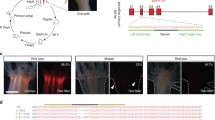Abstract
Functional approaches for studying embryonic development have greatly advanced thanks to the CRISPR-Cas9 gene editing technique. Previously practiced in just a few organisms, these knockout techniques are now widely applied. Here we describe simple techniques for applying the CRISPR-Cas9 system to study the development of the nerve cord in the ascidian Phallusia mammillata.
Access this chapter
Tax calculation will be finalised at checkout
Purchases are for personal use only
Similar content being viewed by others

References
Satoh N (2016) Two decades of ascidian developmental biology: a personal research story. Curr Top Dev Biol 117:289–300. https://doi.org/10.1016/bs.ctdb.2015.11.016
Conklin EG (1905) The organization and cell-lineage of the ascidian egg. J Acad Natl Sci Philadelphia 13:1–119
Delsuc F, Philippe H, Tsagkogeorga G et al (2018) A phylogenomic framework and timescale for comparative studies of tunicates. BMC Biol 16:39. https://doi.org/10.1186/s12915-018-0499-2
Nishida H (2005) Specification of embryonic axis and mosaic development in ascidians. Dev Dyn 233:1177–1193. https://doi.org/10.1002/dvdy.20469
Lemaire P (2009) Unfolding a chordate developmental program, one cell at a time: invariant cell lineages, short-range inductions and evolutionary plasticity in ascidians. Dev Biol 332:48–60. https://doi.org/10.1016/j.ydbio.2009.05.540
Guignard L, Fiuza U-M, Leggio B et al (2018) Contact-dependent cell communications drive morphological invariance during ascidian embryogenesis. bioRxiv 238741. https://doi.org/10.1101/238741
Stach T, Anselmi C (2015) High-precision morphology: bifocal 4D-microscopy enables the comparison of detailed cell lineages of two chordate species separated for more than 525 million years. BMC Biol 13:113. https://doi.org/10.1186/s12915-015-0218-1
Madgwick A, Magri MS, Dantec C et al (2019) Evolution of embryonic cis-regulatory landscapes between divergent Phallusia and Ciona ascidians. Dev Biol 448(2):71–87. https://doi.org/10.1016/j.ydbio.2019.01.003
Costache V, Hebras C, Pruliere G et al (2017) Kif2 localizes to a subdomain of cortical endoplasmic reticulum that drives asymmetric spindle position. Nat Commun 8:917. https://doi.org/10.1038/s41467-017-01048-8
Hibino T, Nishikata T, Nishida H (1998) Centrosome-attracting body: a novel structure closely related to unequal cleavages in the ascidian embryo. Develop Growth Differ 40:85–95
Dumollard R, Hebras C, Besnardeau L, McDougall A (2013) Beta-catenin patterns the cell cycle during maternal-to-zygotic transition in urochordate embryos. Dev Biol 384:331–342. https://doi.org/10.1016/j.ydbio.2013.10.007
Dumollard R, Minc N, Salez G et al (2017) The invariant cleavage pattern displayed by ascidian embryos depends on spindle positioning along the cell’s longest axis in the apical plane and relies on asynchronous cell divisions. Elife 6:e19290. https://doi.org/10.7554/eLife.19290
Tassy O, Daian F, Hudson C et al (2006) A quantitative approach to the study of cell shapes and interactions during early chordate embryogenesis. Curr Biol 16:345–358. https://doi.org/10.1016/j.cub.2005.12.044
Hudson C (2016) The central nervous system of ascidian larvae. Wiley Interdiscip Rev Dev Biol 5:538–561. https://doi.org/10.1002/wdev.239
Hudson C, Lotito S, Yasuo H (2007) Sequential and combinatorial inputs from Nodal, Delta2/Notch and FGF/MEK/ERK signalling pathways establish a grid-like organisation of distinct cell identities in the ascidian neural plate. Development 134:3527–3537. https://doi.org/10.1242/dev.002352
Navarrete IA, Levine M (2016) Nodal and FGF coordinate ascidian neural tube morphogenesis. Development 143:4665–4675. https://doi.org/10.1242/dev.144733
Jiang D, Munro EM, Smith WC (2005) Ascidian prickle regulates both mediolateral and anterior-posterior cell polarity of notochord cells. Curr Biol 15:79–85
Yasuo H, Satoh N (1998) Conservation of the developmental role of Brachyury in notochord formation in a urochordate, the ascidian Halocynthia roretzi. Dev Biol 200:158–170
Nishiyama A, Fujiwara S (2008) RNA interference by expressing short hairpin RNA in the Ciona intestinalis embryo. Develop Growth Differ 50:521–529. https://doi.org/10.1111/j.1440-169X.2008.01039.x
McDougall A, Chenevert J, Pruliere G et al (2015) Centrosomes and spindles in ascidian embryos and eggs. Methods Cell Biol 129:317–339. https://doi.org/10.1016/bs.mcb.2015.03.006
Arimoto R, Murray JM (2004) A common aberration with water-immersion objective lenses. J Microsc 216:49–51. https://doi.org/10.1111/j.0022-2720.2004.01383.x
Haeussler M, Schönig K, Eckert H et al (2016) Evaluation of off-target and on-target scoring algorithms and integration into the guide RNA selection tool CRISPOR. Genome Biol 17:148. https://doi.org/10.1186/s13059-016-1012-2
Acknowledgments
We would like to thank members of the Ascidian BioCell team and Janet Chenevert for helpful comments. We would also like to thank the funding agencies that support our work: the French government funding agency Agence National de la Recherche (ANR “MorCell”: ANR-17-CE 13-0028) and Sorbonne University for supporting the Réseau André Picard. We would also like to thank the European Union’s Horizon 2020 research and innovation programme under grant agreement No 730984, ASSEMBLE Plus project. Finally, we also thank the members of the Service Aquariologie (Laurent Gilletta, Alexandre Jan, and Régis Lasbleiz) for maintaining the animals, and the Institut de la Mer de Villefranche (IMEV) that is supported by EMBRC-France, whose French state funds are managed by the ANR within the Investments of the Future program under reference ANR-10-INBS-02.
Author information
Authors and Affiliations
Corresponding author
Editor information
Editors and Affiliations
1 Electronic Supplementary Material
Movie1. (Mp4 92.3mb)
Rights and permissions
Copyright information
© 2021 Springer Science+Business Media, LLC, part of Springer Nature
About this protocol
Cite this protocol
McDougall, A., Hebras, C., Gomes, I., Dumollard, R. (2021). Gene Editing in the Ascidian Phallusia mammillata and Tail Nerve Cord Formation. In: Carroll, D.J., Stricker, S.A. (eds) Developmental Biology of the Sea Urchin and Other Marine Invertebrates. Methods in Molecular Biology, vol 2219. Humana, New York, NY. https://doi.org/10.1007/978-1-0716-0974-3_13
Download citation
DOI: https://doi.org/10.1007/978-1-0716-0974-3_13
Published:
Publisher Name: Humana, New York, NY
Print ISBN: 978-1-0716-0973-6
Online ISBN: 978-1-0716-0974-3
eBook Packages: Springer Protocols



